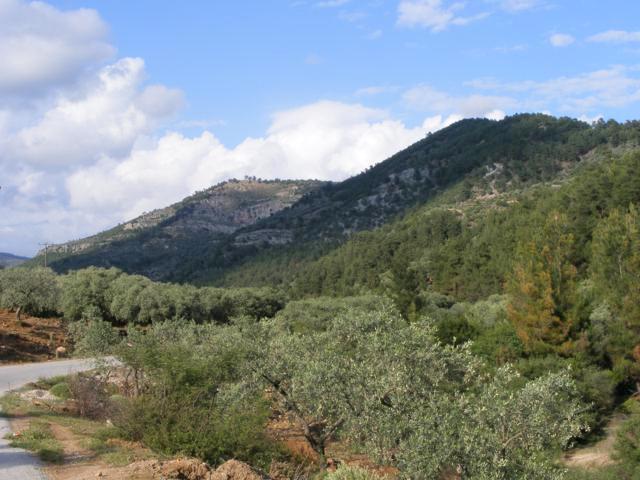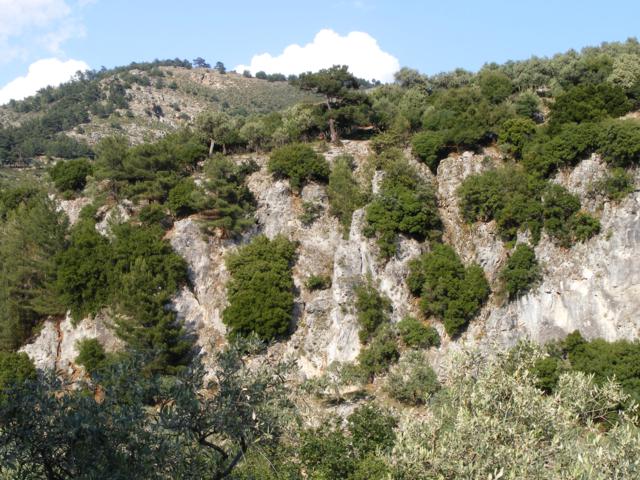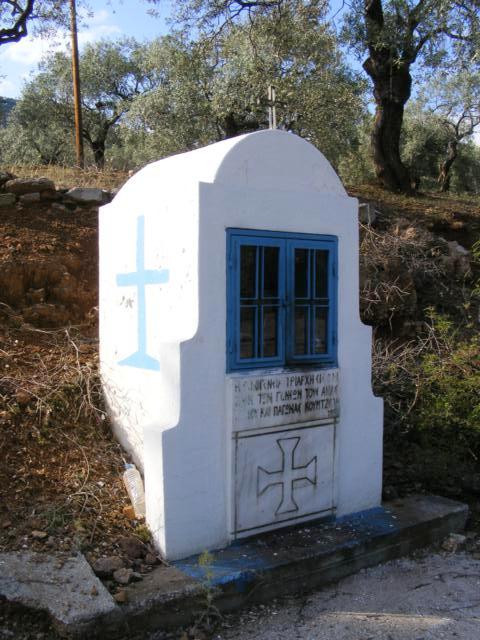Acesta mi s-a parut un nume ciudat, fara rezonanta greceasca. Gazda mi-a spus ca se numeste asa fiindca, dintotdeauna, aproape toate femeile din sat se numesc Maria. Mi s-a parut frumos! Apoi, gugalind, am gasit si o alta explicatie. Se pare ca, in urma unui atac pirateresc, care a distrus satul, ar fi ramas in viata doar doua femei, ambele cu numele de Maria.
Asezarea a fost fondata in timpul Bizantului si se afla la o altitudine de 200 m. Astazi ea numara doar 700 de locuitori. Cultivarea maslinilor (irigati!) si albinaritul sunt principalele lor ocupatii.
in drum spre Maries
Maries nu este un sat turistic, ca Panaghia, Kazaviti sau Theologos. Accesul se face din Limenaria. Am mers totusi acolo, sa vad daca mai pot gasi case vechi. Pe drumul care duce spre sat printre livezi de maslini si marginit de coastele dealurilor, se afla doua mici bisericute pe care le-am privit – din nou – printre zabrele.
livezi de maslini
Era tarziu dupa-amiaza si o lumina aurie invaluia dealuriel si casele. In sat, casele terasate, pline de flori si vita de vie, se insira pe stradute intortocheate.
Cu greu gasesc cateva vechi si una in renovare.
Cele care au fost deja renovate se observa usor.
In rest, case noi.
Traditionala taverna din mijlocul satului e cam pustie. Langa ea se afla biserica, una din cele mai vechi de pe insula, construita in 1800. Admir, de sus, acoperisul sau de ardezie si clopotnita adaugata mai tarziu, vopsita in alb si rosu inchis. Oameni doar ici colo, privind curiosi spre noi.
biserica, vazuta de sus
clopotnita
Inapoi, spre casa, admiram de pe drum Limenaria si albastrul marii. In departare, e muntele Athos.
de la Maries spre Limenaria
schitul Sf. Trifon
in plan secund, incetosat, Muntele Athos
Thassos Revisited 9. Mountain Villages: Maries
This name – it seems to me – lacks the Greek resonance. The owner of my accommodation told me that this is because almost all women in the village are named Maria. I thought this is nice! Looking later on Google I found out a legend that says that after a pirates’ raid, who destroyed the village, the only two survivors have been two women, both named Maria.
The village was founded during Byzantine time. It stays at 200 m high above the sea, and it has 700 inhabitants. Their main occupations are olive trees cultivation and beekeeping.
This is not a touristic village like Panaghia, Kazaviti or Theologos. You may drive there from Limenaria. It was late afternoon when we went there and a golden light enveloped hills and houses.
It was difficult to find some old houses. The most of them were renovated (it shows easily)or new ones. In the middle of the village the tavernas are deserted. The oldest church on the island, built at 1800, has its gate closed. I looked at the roof, covered with stone slates, and nearby the bell tower, added much later, now painted in white and dark red. It is nice to walk on the narrow, windy streets, seeing the vines and the flowers. Few people, here and there, looking couriously toward us.
Back to Limenaria, we admired from the road the village and the sea and the distant Mt. Athos.




I like all of the blue trim.
Thanks, Randy! It’s a characteristic in Greek architecture.
I like seeing the road side shrines. I remember seeing them in Italy too. That’s something rarely seen in the US.
Yes, I know Doug. Thanks for the comment (currently still in Uzbekistan).
I see indeed a kind of chapel on the 3rd picture, but also to other photos you see that faith plays a major role. Beautiful like you describe how this village was founded during the Byzantine era.
Very nice blog again.
Thank you, Helma!